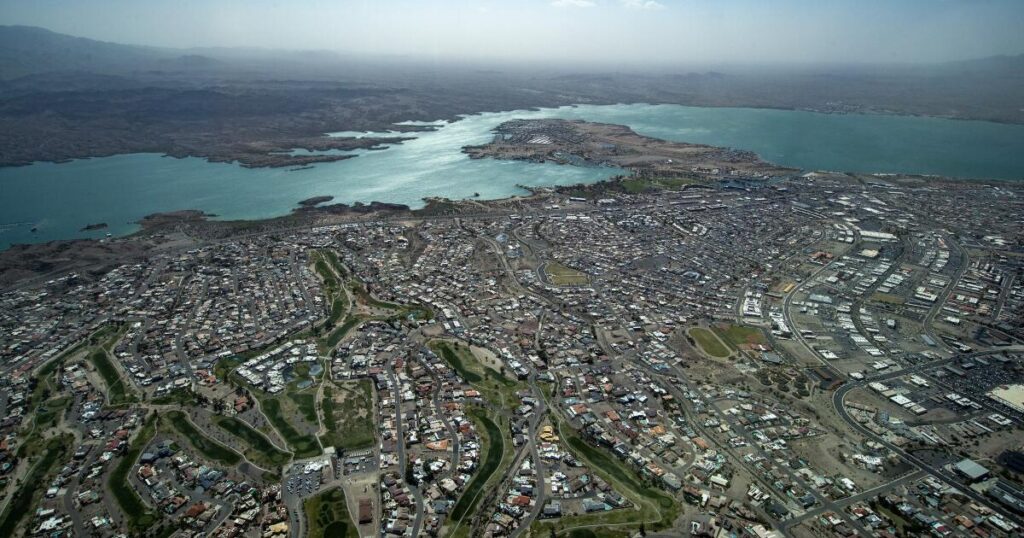In 1968, inventor Robert McCulloch purchased the decommissioned London Bridge for $2.4 million and began to move it to newly founded Lake Havasu City, Ariz.
Each of the bridge’s 10,276 granite blocks were shipped by sea to Long Beach, then trucked to Arizona.
Back then, moving the London Bridge to the desert elicited chuckles and curiosity in California. But in recent years, increasing numbers of Californians are taking that same trek from the coast to start new lives in Lake Havasu.
The town famed for its spring break recreation might not be the first place that comes to mind when Californians think about relocating.
After all, in raw numbers, the biggest destination for Californians in the last few years has been Texas. When it comes to migration to Arizona, Maricopa County — home to Phoenix — saw the largest influx of Californians by sheer numbers, at 36,000 in 2023, U.S. Census data show.
But Lake Havasu City is impressive in two key metrics:
Far more Californians move to the town per capita compared to the Phoenix area.
In 2023, which was the last year that data were available, 5,358 Californians moved to Mojave County (home to Havasu) compared to only 2,651 Arizonans. That is the highest ratio in Arizona.
So the city offers a useful window into how Californians resettle when they cross the Golden State border.
Amber Whitehead lived the first 47 years of her life in California before moving to Lake Havasu City full-time in 2024.
Now, she worries too many others are following her.
“I don’t want to talk it up too much, cause we don’t want a bunch of people moving in from California,” Whitehead said with a chuckle.
She and her boyfriend sold their home in the Tuolumne County foothills east of Stockton in 2024 after trying the snowbird lifestyle — splitting time between the Sierra and Arizona — the year before and loving it.
“The cost of living in California is just getting ridiculous, so we decided it was time to sell,” she said. Her fire insurance had doubled in the year before she left, and she found much lower property taxes across the Colorado River. She also preferred her new state’s governor and politics.
Whitehead had dealt with some adjustments, mostly good: friendlier people and no more snow to hassle with.
“I mean, 115 in the summer is a little bit to adjust to,” Whitehead said, adding that her pool helps her endure the heat. She sometimes misses the ocean and the fall colors of her home state.
“I try to not even tell everybody that we’re from California,” she said, “but most of the people that we run into here are from California.”
Lake Havasu City now has nearly 60,000 residents, growing at a steady clip over the last two decades. But the beginning of the pandemic saw the start of a California migration boom as people looking for open space flocked there. The ability to work remotely during the pandemic also contributed to the exodus.
The influx was a boon for the economy but left some residents worried all those weekend visitors could contribute to the spread of COVID-19.
But the popularity of the city remained even as the pandemic faded.
Kristina Horton moved to Lake Havasu City in 2004 and began brokering real estate there shortly before the pandemic-driven boom began.
The majority of her clients come from California, looking for second homes, she said. Since she began working as a real estate agent, the luxury market has exploded: in 2019, there were about 10 homes valued at more than a million dollars on the market at a given time. Now, there are more than 100.
The median home price is about $435,000, making it much more affordable as a lakeside getaway than many vacation destinations one state over.
Clients follow a predictable pattern as they adopt the city as their new home, she said.
“People would complain that they didn’t want Californians to change Lake Havasu into California, even though many of them were from there,” Horton said, adding that “their view seemed to change as they moved over.”
Time will tell whether Lake Havasu City remains a draw. The “California Exodus” largely ended with the pandemic, and the state’s population is again growing. Some areas like Arizona and Texas that once looked like great deals have seen housing prices rise in recent years, making them less appealing to some.
For years, Southern Californians have come to Havasu in search of a vacation home, said Lake Havasu City Mayor Cal Sheehy, but the pandemic gave many the added incentive to move into their secondary homes full-time.
“It’s a sentiment that’s known wide in our area that so many people came from California,” Sheehy said, referencing the ‘Don’t California my Arizona’ meme. Upon arrival, he said, they’ll quickly discover: “We do it our way.”
Lower taxes also can be a draw for snowbirds to make the move permanently, Sheehy argued.
As population growth in California slowed, falling temporarily to negative rates for the first time in state history, Arizona kept growing.
Arizona’s population grew 5.4% from 2020 to 2024, while California’s essentially stayed the same. The state managed to add 6.7% to its housing stock over the same period, while California added a paltry 3.1%, per Census data.
For Horton’s clients, proximity to the Golden State means connection to its real estate cycle. Like California’s housing market, the local market has cooled since a red-hot start to the 2020s. New housing is primarily on the higher end, possibly “changing the fabric of Havasu,” she said.
Though the city has grown into a luxury destination and moved partially away from its spring break heritage, Horton still avoids the London Bridge area in March. “I don’t think it’s as crazy as it used to be.”
“If you don’t know what a pastie is, you’ll learn when you get here,” she said, referencing the skimpy stick-on swimwear favored by spring breakers.
The post This Arizona town is an unexpected magnet for Californians: ‘We do it our way’ appeared first on Los Angeles Times.




